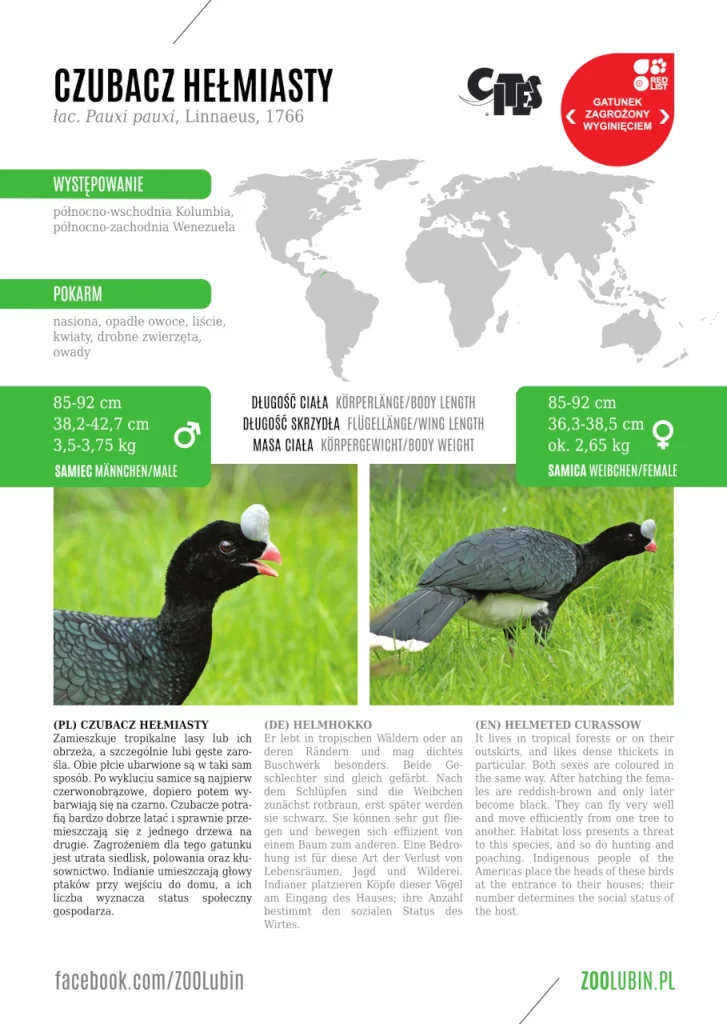
POBIERZ ETYKIETĘ GATUNKOWĄ – PLIK PDF (rozmiar 2290 KB)
Czubacz hełmiasty (PL)
łac. Pauxi pauxi, Linnaeus, 1766
Zamieszkuje tropikalne lasy lub ich obrzeża, a szczególnie lubi gęste zarośla. Obie płcie ubarwione są w taki sam sposób. Po wykluciu samice są najpierw czerwono-brązowe, dopiero potem wybarwiają się na czarno. Czubacze potrafią bardzo dobrze latać i sprawnie przemieszczają się z jednego drzewa na drugie. Zagrożeniem dla tego gatunku jest utrata siedlisk, polowania oraz kłusownictwo. Indianie umieszczają głowy czubaczy przy wejściu do domu, a ich liczba jest wyznacznikiem statusu społecznego gospodarza.
Występowanie: północno-wschodnia Kolumbia, północno-zachodnia Wenezuela
samiec / samica
Długość ciała: 85–92 cm
Rozpiętość skrzydeł: 38,2–42,7 cm / 36,3–38,5 cm
Masa ciała: 3,5–3,75 kg / ok. 2,65 kg
Helmhokko (DE)
łac. Pauxi pauxi, Linnaeus, 1766
Er lebt in tropischen Wäldern oder an deren Rändern und fühlt sich besonders gut im dichten Buschwerk. Beide Geschlechter sind gleich gefärbt. Nach dem Schlüpfen sind die Weibchen zunächst rotbraun, erst später werden sie schwarz. Helmhokkos können sehr gut fliegen und bewegen sich effizient von einem Baum zum anderen. Sie sind durch den Verlust von Lebensräumen, Jagd und Wilderei bedroht. Indianer stellen Köpfe dieser Vögel am Eingang des Hauses; die Anzahl der Köpfe bestimmt den sozialen Status des Wirtes.
Vorkommen: Nordost-Kolumbien, Nordwest-Venezuela
Männchen / Weibchen
Körperlänge: 85–92 cm
Flügelspannweite: 38,2–42,7 cm / 36,3–38,5 cm
Körpermasse: 3,5–3,75 kg / ca. 2,65 kg
Helmeted curassow (EN)
łac. Pauxi pauxi, Linnaeus, 1766
It lives in tropical forests or on their outskirts, being particularly fond of dense thickets. Both sexes are coloured in the same way. After hatching the females are reddish-brown at first and only later do they become black. They can fly very well and move efficiently from one tree to another. Habitat loss presents a threat to this species; so do hunting and poaching. Local indigenous people place heads of these birds at the entrance to their houses; the number
of the heads determines the social status of the host.
Distribution: North-East Colombia, North-West Venezuela
male / female
body length: 85–92 cm
wingspan: 38,2–42,7 cm / 36,3–38,5 cm
body mass: 3,5–3,75 kg / ca. 2,65 kg
